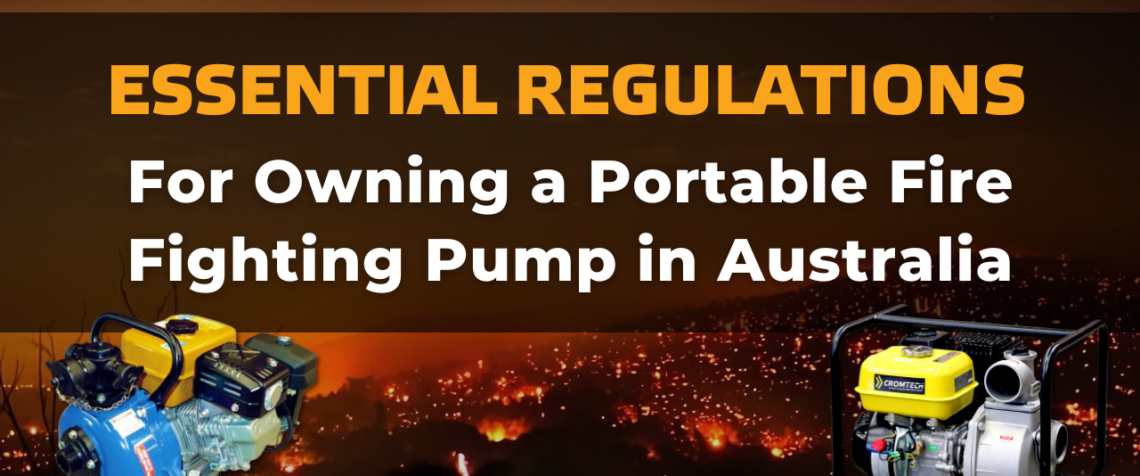Fire fighting pumps are an essential part of fire prevention and control, especially for rural and high-risk areas in Australia. However, owning and operating a portable fire fighting pump involves understanding various compliance requirements and best practices. Whether you’re a farmer, rural or volunteer firefighter, or part of the construction or mining industries, it’s crucial to stay informed and follow these standards to ensure both safety and legality.
Overview of Australian Fire Safety Regulations
In Australia, there are regulations in place that govern the operation and maintenance of fire fighting equipment, including portable fire fighting pumps. While many of these standards are aimed at large commercial systems, some guidelines are still relevant for smaller-scale equipment.
One important standard to be aware of is Australian Standard AS 1851, which provides recommendations for the routine service of fire protection systems. For portable fire pumps, this could mean regular checks and maintenance to ensure they are operational when needed, especially during bushfire season. While large commercial systems require frequent checks, domestic users such as farmers might focus on seasonal inspections and servicing, ensuring the pump is ready for fire emergencies.
Environmental Compliance
Water is a critical resource during firefighting, but in many rural areas, especially those affected by drought, there are guidelines on how water sources can be used. When using a portable fire fighting pump, it’s important to comply with any local water restrictions. To identify the specific regulations in your region, consult with your local fire authority or council.
Fuel and emissions regulations also apply to portable fire pumps. Many pumps run on diesel or petrol, and it’s important to ensure that your equipment meets local environmental guidelines regarding emissions. This may include using more fuel-efficient models or taking care of the environment when storing and transporting fuel for your pump. Minimising noise and emissions are particularly relevant in sensitive areas or conservation zones.
Equipment Maintenance and Safety Standards
To ensure your portable fire pump is reliable during an emergency, regular maintenance is essential. For rural property owners and volunteer firefighters, the following maintenance tasks are recommended:
- Seasonal Inspections: Before bushfire season, check the pump for any signs of wear, such as leaks, damaged hoses, or corroded parts. Ensure that the fuel system is functioning correctly and that fuel is fresh and stored safely.
- Functional Testing: It’s a good idea to test your pump at least once a month during fire season. Run the pump for a few minutes to ensure it is delivering adequate water pressure and flow.
- Annual Servicing: Once a year, service your pump to ensure everything is in working order. This should include checking all mechanical components, fuel systems, and any safety features like pressure relief valves.
Check out our tutorial on how to service your fire fighting pump:
Maintaining a service log or records of when inspections and servicing occur is a good practice, particularly for volunteer fire brigades or those with more complex fire management needs.
Storage and Transport Regulations
Storing and transporting your portable fire pump correctly ensures it’s always ready for use. In rural settings, pumps should be stored in a dry, secure location where they are protected from the elements but can still be easily accessed during an emergency.
When transporting fire pumps on vehicles, ensure they are securely fastened, and that fuel tanks are sealed to prevent leaks. If crossing state lines, check local regulations, as some states may have specific requirements regarding the transportation of fuel-powered equipment, particularly during fire bans or high-alert periods.
Regional Variations
Regulations and guidelines for fire fighting equipment can vary between states and territories. For example, in Western Australia, fire risk is extremely high during the summer months, and property owners may be required to have certain fire protection measures in place, including portable fire pumps. In New South Wales and Victoria, there may be local council rules or fire service guidelines that affect how and when you can use your portable fire pump.
Always check with your local fire authority or council for the most up-to-date regulations and recommendations for your area, especially before the start of fire season.
Training and Usage Guidelines
Using a fire fighting pump during an emergency requires skill and knowledge to ensure it is used safely and effectively. In Australia, there are no strict legal requirements for domestic users regarding training, but it is highly recommended to familiarise yourself with the operation of your pump. Volunteer firefighters should undergo formal training to ensure they meet safety standards when using portable fire fighting pumps.
For property owners, it’s a good idea to practice using your pump before fire season starts. This ensures you know how to set it up quickly, use it correctly, and troubleshoot any issues that may arise under pressure. Being prepared can make all the difference during an emergency.
Be Fire Ready
Owning a portable fire fighting pump provides peace of mind for rural property owners and volunteer firefighters, but it’s important to ensure that you are following the relevant regulations and best practices. From maintaining your equipment and checking for compliance with water and fuel regulations, to proper storage and usage during emergencies, these steps will help you stay prepared.
Need a new fire pump? Explore the Crommelins Machinery range.




